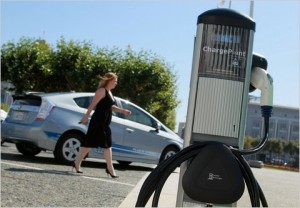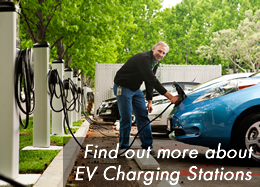Carbon Day Automotive is a Leader in Electric Vehicle (EV) Charging Infrastructure
Carbon Day Automotive is a market leader in electric vehicle charging infrastructure. As a master distributor for Coulomb Technologies, we have industry leading experience utilizing premiere technology with thousands of charging stations installed on our network.
All stations are powered by the ChargePoint Network, providing real-time station location, status, and driver/host interaction. Owners of stations can set real time pricing at their own preference and collect the revenue from charging sessions. Drivers receive real-time SMS/Email notifications about charging status.
How to Reduce Your Carbon Foot Print
There are many simple ways to reduce the footprint you leave on the planet. Learn how to reduce your footprint in each consumption category–carbon, food, housing, and goods and services—but don’t stop there. Amplify your impact by encouraging others to follow your lead. Engage your friends and community with local and global movements for social change, or start your own movement!
Reduce your Carbon Footprint
Use Cleaner Transport
- Walk, bike, or take public transit whenever possible.
- Avoid allowing your car to idle. If you’ll be waiting for more than 30 seconds, turn off the engine (except in traffic). And don’t take the drive-through. Park the car and walk inside instead.
- Have your vehicle serviced regularly to keep the emission control systems operating at peak efficiency. Check your car’s air filter monthly, and keep the tires adequately inflated to maximize gas mileage.
- Avoid short airplane trips—take a bus or train instead.
Add Energy-Saving Features to your home
- Install compact fluorescent bulbs in all your home light fixtures—but remember, compact fluorescents contain mercury, so look for low-mercury models and be sure to dispose of old bulbs safely through your local hazardous waste program.
- Weatherproof your home. Make sure your walls and ceilings are insulated, and consider double-pane windows. Eliminate drafts with caulking, weather strips, and storm windows and doors.I
- nsulate your water heater. Even better, switch to a tankless water heater, so your water will be heated only as you use it.
- Choose energy efficient appliances.
Adopt Energy-Saving Habits
- Keep thermostat relatively low in winter and ease up on the air conditioning in summer. Clean or replace dirty air conditioner filters as recommended to keep the A/C operating at peak efficiency.
- Unplug your electronics when not in use. To make it easier, use a power strip. Even when turned off, items like your television, computer, and cell-phone charger still sip power.
- Dry your clothes outside whenever possible.
- Make minimal use of power equipment when landscaping.
- Defrost your refrigerator and freezer regularly.
- Choose green electricity. Many utilities give you the option to purchase electricity generated by wind and solar power for a small rate surcharge.
- Purchase carbon offsets to make up for the energy use you can’t eliminate.
Reduce your Food Footprint
- Eat more local, organic, in-season foods.
- Plant a garden—it doesn’t get more local than that.
- Shop at your local farmer’s market or natural foods store. Look for local, in-season foods that haven’t traveled long distances to reach you.
- Choose foods with less packaging to reduce waste.
- Eat lower on the food chain—going meatless for just one meal a week can make a difference. Globally, it has been estimated that 18% of all greenhouse gas emissions are associated with meat consumption.
Reduce your Housing Footprint
- Choose sustainable building materials, furnishings, and cleaning products.
- Explore green design features for your building, like passive solar heating, a rainwater catchment or grey water recycling system, and recycled materials.
- Choose efficient appliances, including low flow shower-heads, faucets, and toilets.
- Choose furnishings that are second-hand, recycled, or sustainably produced.
- Plant drought tolerant plants in your garden and yard.
- Use biodegradable, non-toxic cleaning products.
Adopt Water-Saving Habits
- Take shorter, less frequent showers—this not only saves water, but the energy necessary to heat it.
- Don’t use the garbage disposal. Compost instead.
- Run the dishwasher and the laundry machine only when full.
- Wash cars rarely, or better yet, take them to a carwash. Commercial carwashes use less water per wash than home washers, and they are also required to drain used water into the sewage system, rather than storm drains, which protects aquatic life.
- Avoid hosing down or power-washing your deck, walkways, or driveway.
- Regularly look for and fix leaks.
- Turn off the water when you brush your teeth. If everyone did this simple step we would save the equivalent of the great lakes every year.
- Buy a rain barrel to capture excess rain from the gutters which can be used to water your garden.
Reduce your Goods and Services Footprint
- Buy less! Replace items only when you really need to.
- Recycle all your paper, glass, aluminum, and plastic. Don’t forget electronics!
- Compost food waste for the garden. Garbage that is not contaminated with degradable (biological) waste can be more easily recycled and sorted, and doesn’t produce methane gases (a significant greenhouse gas contributor) when stored in a landfill.
- Buy recycled products, particularly those labeled “post-consumer waste.”
What Is A Carbon Footprint?

What is A Carbon Footprint?
A carbon footprint is a measure of the impact our activities have on the environment, and in particular climate change. It relates to the amount of greenhouse gases produced in our day-to-day lives through burning fossil fuels for electricity, heating and transportation etc.
The carbon footprint is a measurement of all greenhouse gases we individually produce and has units of tonnes (or kg) of carbon dioxide equivalent.
Each of us needs to “Play a Part” to reduce our Carbon Footprint.
After all
THE ONLY THING WE HAVE TO LOSE IS CARBON.
Today, it is more important than ever to reduce our Carbon Footprint.
Not only are the developed countries producing more and more carbon emissions, but there is now a growing problem as the population in Africa and Asia start changing their lifestyles in ways that consume more energy.
We need to lead the way…
A carbon footprint is made up of the sum of two parts, the primary footprint (shown by the green slices of the pie chart) and the secondary footprint (shown as the yellow slices)
1. The primary footprint is a measure of our direct emissions of CO2 from the burning of fossil fuels including domestic energy consumption and transportation (e.g. car and plane). We have direct control of these.
2. The secondary footprint is a measure of the indirect CO2emissions from the whole lifecycle of products we use – those associated with their manufacture and eventual breakdown. To put it very simply – the more we buy the more emissions will be caused on our behalf.
To calculate your carbon footprint - click here
For tips to reduce your footprint - click here
Follow these Links for More Information on carbon reducing technologies:
Cutting Down on Energy Consumption
Sept. 15 Is Carbon Day
Celebrate Carbon Day on September 15th!
At Carbon Day we believe that everyone should “PLAY A PART” and work towards the goal of reducing each person’s carbon footprint.
Inevitably, when going about our daily lives — commuting, sheltering our families, eating — each of us contributes to the greenhouse gas emissions that are causing climate change.
There are many things each of us, as individuals and organizations, can do to reduce our carbon emissions.
The choices we make in our homes, offices, our travel, the food we eat, and what we buy and throw away all influence our carbon footprint and if we become conscious of these choices, we can help ensure a stable climate for future generations. We believe in sustainability and the benefits a sustainable world can bring.
September 15th has been designated as the official Carbon Day Holiday. This presents each of us with the opportunity to create an event, large and small, in our own community to educate one another about energy efficiency and how to reduce our individual and collective Carbon Footprint.
We will provide you with materials that will assist in planning and setting up your own Carbon Day Holiday event. You can register your events in our database and show how you are Playing your Part.
If you would like additional information about Carbon Day Automotive, please view our website atwww.CarbonDayAutomotive.com Play a Part™ and Plug In!
Contact
Carbon Day Welcomes all comments and suggestions on how we can improve our message.
Please be patient as we try and answer the inquiries in the order that we receive them.
We are always looking for qualified and responsible individuals or groups who would like to sponser or hold an event on Carbon Day which is Sept 15.
Please direct all correspondence to the correct party listed below.
Events
Carbon Day Events or to volunteer in other ways 800 W. Huron suite 4E Chicago, IL 60642
Phone: 312.275.5747 Fax: 312.276.4855 BenL@carbonday.com
CDA
Carbon Day Automotive – If you would like information on how to purchase an electric vehicle charging station or to become a qualified reseller.
800 W. Huron suite 4E Chicago, IL 60642 ScottE@carbonday.com
For Media Requests please contact:
Jane Kaplan Communications 400 Park Avenue, Suite D Highland Park, IL 60035 Phone–847.433.8594 Fax–847.433.8505 jane@jkaplancommunications.com
Tree Facts
- Two mature trees provide enough oxygen for a family of four
- One acre of trees removes 2.6 tons of CO2 per year
- About one third of the United States of America is covered by forests
- The average tree in an urban










